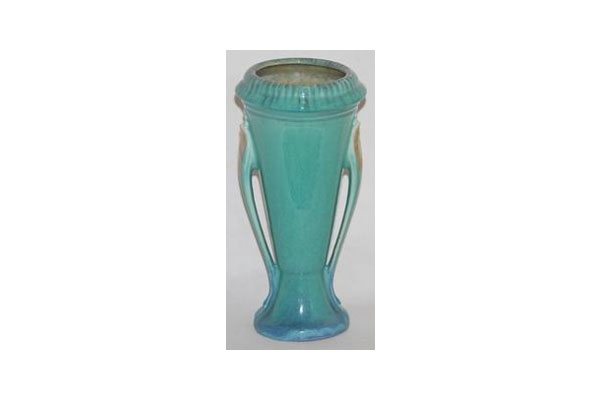 The middle period line that’s all about vivid colors and a rich gloss glaze is Roseville’s Orian; curiously, it’s also one that’s often overlooked. Considered art deco, this contemporary collection offers those vibrant colors this time period is known for and certainly presents the willingness to take a risk that Roseville Pottery was known to do.
The middle period line that’s all about vivid colors and a rich gloss glaze is Roseville’s Orian; curiously, it’s also one that’s often overlooked. Considered art deco, this contemporary collection offers those vibrant colors this time period is known for and certainly presents the willingness to take a risk that Roseville Pottery was known to do.
In the mid-1930s, during the height of its popularity, it was referred to as a “solid color line that is a real achievement in ceramic art…inspired directly or indirectly by the Chinese vases of the Ming period”. It was also noted for the unique contours and glaze combinations. It’s interesting, too, that while trying to grasp the right adjectives for this post, I ran across an apt description related to the designs: “shapes are lovely but in no way extreme”. That’s true, too – they’re unique and certainly creative, but we’re not talking on the level, of say, the aggressive designs George Ohr was known for. The result is a fun presentation of narrow handles, wider vases and pedestal bases – lots of pedestal bases.
It’s believed there were sixteen shapes with this Roseville pattern – and they’re all beautiful choices. If you run across them, and if you’re an art deco fan, odds are, it’s going to be difficult to pass up. There are several vases in a wide range of heights, widths and glaze colors, along with bowls, candlesticks, wall pockets and even a lovely rose bowl.
You’ll recognize the Roseville Orian. Look for the glossy finish, smart color combinations (one favorite is the yellow and  green that really makes the vases stand out). Also, those narrow and usually low resting dual handles are generally a giveaway along with the classic “pedestal base”. While there are several tan pieces, they’re not likely to sell for as much as their more colorful counterparts. Also, note that in the bowls, the interior of the actual bowl is usually white, which is a nice contrast with the reds, greens and yellows on the outside of the pieces.
green that really makes the vases stand out). Also, those narrow and usually low resting dual handles are generally a giveaway along with the classic “pedestal base”. While there are several tan pieces, they’re not likely to sell for as much as their more colorful counterparts. Also, note that in the bowls, the interior of the actual bowl is usually white, which is a nice contrast with the reds, greens and yellows on the outside of the pieces.


